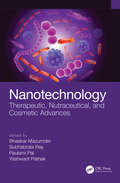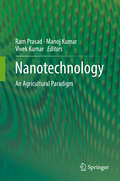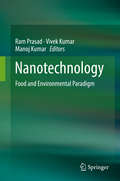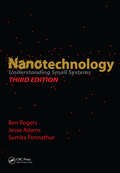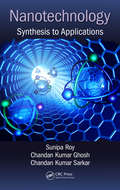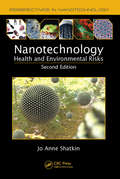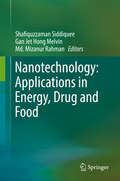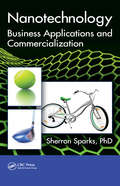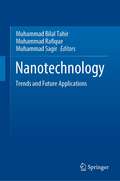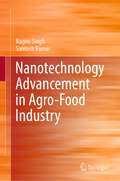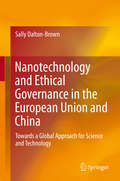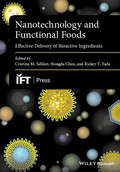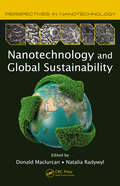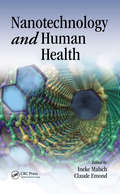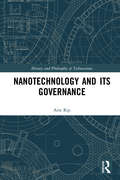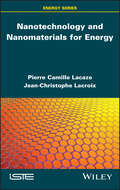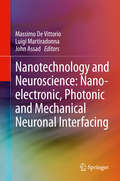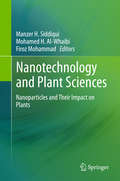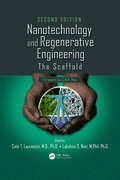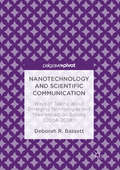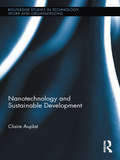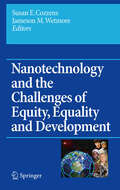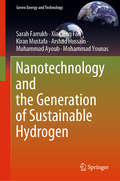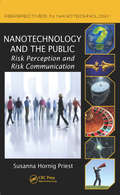- Table View
- List View
Nanotechnology: Therapeutic, Nutraceutical, and Cosmetic Advances (Nutraceuticals Ser. #4)
by Bhaskar Mazumder Subhabrata Ray Paulami Pal Yashwant PathakToday we find the applications of nanotechnology in all spheres of life. Nanotechnology: Therapeutic, Nutraceutical and Cosmetic Advances discusses recent advances in the field, particularly with therapeutics, nutraceuticals and cosmetic sciences. <P><P>Therapeutics is an area which has perhaps benefitted the most, although nanoscience and technology have quietly entered the realms of food science and are playing pivotal roles in the efficient utilization of nutraceuticals. Finally, even before therapeutics came cosmetics and companies started marketing unique products embedding the beneficial and advanced properties enabled by the use of nanostructures. This book highlights trends and applications of this wonderful new technology.
Nanotechnology
by Ram Prasad Manoj Kumar Vivek KumarThe New Frontiers of Organic and Composite Nanotechnology is an attempt to illustrate current status of modern nanotechnology. The book is divided into 3 main sections, introduction and conclusion. The introduction describes general questions of the problem and main lines of the research activities. In the first section methods of the nanostructures construction are described. Second section is dedicated to the Structure-property relationship. Special attention is paid to the description of the most powerful experimental methods and tools used in nanotechnology, such as probe microscopies, spectroscopied, and scattering methods, including the utilization of synchrotron radiation facilities. The third section describes the applications of nanotechnology in electronics, biotechnology and diagnostics. Conclusion part presents a summary of the status of works in this area and gives some perspectives of the further development. Reference to practically all original works with essential results, that resulted in the development of nanotechnology Coherent group of well-known authors in the field of nanotechnology Book spans topics applicable for both the didactic and research
Nanotechnology
by Ram Prasad Vivek Kumar Manoj KumarThe latest developments in nanotechnology and detailed application methodologies to decontaminate water, air, soil, and foodWritten by a team of global experts, "Nanotechnology for Environmental Decontamination" summarizes the techniques to structure target-specific nanomaterial, and how to apply it to decontaminate the natural environment from microbes, heavy metals, industrial toxic chemicals, chemical warfare agents, and biowarfare agents. Recent developments in nanotechnology enable environmental decontamination through several target-specific nanomaterials, processes, and tools. This groundbreaking work covers these innovative methodologies in complete detail. It is an ideal resource for both professionals and graduate-level students whose specialty is nanotechnology which is applicable to environmental decontamination. "Nanotechnology for Environmental Decontamination" featuresA thorough overview of the most important developments in the field of decontaminationNanomaterial design methodologies for specific targets such as microbes, heavy metals, and chemical/bio agentsContributions from world-renowned leaders in nanotech decontaminationCoverage of a wide variety of diverse applicationsIn-depth details on: Progress in the control of decontamination using nanotechnology; Nanomaterials as a means of decontamination; Photocatalytic inactivation: air and water; Decontamination of heavy metals from water; Nanotechnology as a tool: Removal of a dense nonaqueous phase liquid (DNAPLs) from the ground water; The remediation of microbes and toxic industrial chemicals from the wastewater; Reactive sorbent materials or systems for air-water remediation; The critical investigation of pesticides and explosive removal from soil and ground using innovative technology; Biocatalysts: the scavengers of chemical warfare agent, insecticides, pesticides, explosives, industrial toxic chemicals and heavy metals; Sequestration of greenhouse gases; Antimicrobial coatings and nanoemulsions used in decontamination; Commercial challenges of decontamination and nanotechnology
Nanotechnology: Understanding Small Systems, Third Edition (Mechanical and Aerospace Engineering Series)
by Ben Rogers Jesse Adams Sumita PennathurAn Accessible, Scientifically Rigorous Presentation That Helps Your Students Learn the Real StuffWinner of a CHOICE Outstanding Academic Book Award 2011"� takes the revolutionary concepts and techniques that have traditionally been fodder for graduate study and makes them accessible for all. � outstanding introduction to the broad field of nanotech
Nanotechnology: The Whole Story
by Ben Rogers Jesse Adams Sumita PennathurWinner of an Outstanding Academic Title Award from CHOICE MagazineTransistors using one electron at a time. Seemingly transparent sunscreens made with titanium dioxide particles that block harmful UV rays. Nanometer-sized specks of gold that change color to red and melt at 750 C instead of 1,064 C. Nanotechnology finds the unique properties of thin
Nanotechnology: Synthesis to Applications (Engineering Materials)
by Sunipa Roy Chandan Kumar Ghosh Chandan Kumar SarkarNano particles have created a high interest in recent years by virtue of their unusual mechanical, electrical, optical and magnetic properties and find wide applications in all fields of engineering. This edited volume aims to present the latest trends and updates in nanogenerators, thin film solar cells and green synthesis of metallic nanoparticles with a focus on nanostructured semiconductor devices. Exclusive chapter on electrical transport of nanostructure explains device physics for material properties for reduced dimensions. Additionally, the text describes the functionality of metallic nanoparticles and their application in molecular imaging and optical metamaterials. Piezoelectric nanogenerators has been touched upon from the energy perspective as well. Key Features: • Organized contents on Nanogenerators, VOC sensing, nanoelectronics, and NEMS. • Discusses eco-friendly green synthesis methods for metallic nanoparticles. • Touches upon low power nano devices (e.g. nanogenerators) for energy harvesting with quantum mechanical study. • Thin film/heterojunction based high efficiency solar cell addressed aimed at reducing global energy consumption.
Nanotechnology: Health and Environmental Risks, Second Edition (Perspectives in Nanotechnology)
by Jo Anne ShatkinShould you adopt nanotechnology? If you have already adopted it, what do you need to know? What are the risks? Nanomaterials and nanotechnologies are revolutionizing the ways we treat disease, produce energy, manufacture products, and attend to our daily wants and needs. To continue to capture the promise of these transformative products, however, we need to ask critical questions about the broader impacts of nanotechnology on society and the environment. Exploring these questions, the second edition of Nanotechnology: Health and Environmental Risks gives you the latest tools to understand the risks of nanotechnology and make better decisions about using it. Examining the state of the science, the book discusses what is known, and what still needs to be understood, about nanotechnology risk. It looks at the uses of nanotechnology for energy, industry, medicine, technology, and consumer applications and explains how to determine whether there is risk—even when there is little reliable evidence—and how to manage it. Contributors cover a wide range of topics, including: Current concerns, among them perceived risks and the challenges of evaluating emerging technology A historical perspective on product safety and chemicals policy The importance of being proactive about identifying and managing health and environmental risks during product development How the concepts of sustainability and life cycle assessment can guide nanotechnology product development Methods for evaluating nanotechnology risks, including screening approaches and research How to manage risk when working with nanoscale materials at the research stage and in occupational environments What international organizations are doing to address risk issues How risk assessment can inform environmental decision making Written in easy-to-understand language, without sacrificing complexity or scientific accuracy, this book offers a wide-angle view of nanotechnology and risk. Supplying cutting-edge approaches and insight, it explains what types of risks could exist and what you can do to address them. What’s New in This Edition Updates throughout, reflecting advances in the field, new literature, and policy developments A new chapter on nanotechnology risk communication, including insights into risk perceptions and the mental models people use to evaluate technological risks An emphasis on developing nanotechnology products that are sustainable in the long term Advances in the understanding of nanomaterials toxicity Cutting-edge research on occupational exposure to nanoparticles Changes in the international landscape of organizations working on the environmental, health, and safety aspects of nanotechnologies
Nanotechnology: Applications in Energy, Drug and Food
by Shafiquzzaman Siddiquee Gan Jet Hong Melvin Md. Mizanur RahmanApplications of nanotechnology are the remarkable sizes dependent on physiochemical properties of nanomaterials that have led to the developed protocols for synthesizing nanomaterials over a range of size, shapes and chemical compositions. Nanomaterials are normally powders composed of nanoparticles which exhibit properties that are different from powders. Nanotechnology is the engineering of functional systems at the molecular scale with their wide applications in energy sector, including -but not limited to- energy resources, energy conversion, energy storage, and energy usage; drug delivery systems including- safety concerns, perspective, challenges, target therapeutics for cancer, neurodegenerative diseases and other human diseases, nanomaterials based tissue engineering; and food sectors including to- food safety and quality, opportunities, challenges, nanomaterials based enhancing food packing, and determination of foodborne pathogens, agro and marine food, analysis of market, regulations and future prospects. The utilization of nanotechnology in the energy field will be emphasized and highlighted, in accordance to their prominent and high impact in this particular field. Recent trends and significant benefits of nanotechnology in the energy field will be revealed to the readers, and their promising advanced applications will be discussed.
Nanotechnology: Business Applications and Commercialization (Nano and Energy)
by Sherron SparksNo longer the hidden genius of scientists, nanotechnology is now appearing in products manufactured for everyday life—products that can heal, save lives, be more durable, and last longer. It is also attracting the attention of investors interested in participating in this nano revolution. Nanotechnology: Business Applications and Commercialization is a guide for businesses, investors, and research universities who want to bring nanotechnology products to the commercial market. Showing how academia and business can partner to commercialize nanomaterial research, it delineates business aspects for scientists and highlights opportunities for business professionals. Some of the key topics covered include: Questions to ask before writing a business plan Products consumers are currently using Grant and funding options Standardization that will affect domestic and international production Dangers that must be managed to ensure the safety of nanotechnology Commercialization centers and organizations that provide support Barriers to nanotechnology commercialization Competitive factors that can help bring the international economy more stability Areas where nanotechnology is expanding This timely book outlines how to harness nanotechnology innovations through the application of strong business principles, drive the standards and development, and take the knowledge to the commercial level with business applications. Filled with case studies and useful resources, it helps readers bridge the "valley of death"—the gap period in capital financing that exists between research and the market adoption of new technologies.
Nanotechnology: Trends and Future Applications
by Muhammad Bilal Tahir Muhammad Rafique Muhammad SagirThis book presents the basic and fundamental aspects of nanomaterials, its types, and classifications with respect to different factors. It contains methods of preparation and characterization of unique nanostructured materials. Consisting of six chapters, this book appeals to a wide readership from academia and industry professionals and is also useful to undergraduate and graduate students focusing on nanotechnology and nanomaterials, sustainable chemistry, energy conversion and storage, environmental protection, opto-electronics, sensors, and surface and interface science. It also appeals to readers who wish to know about the design of new types of materials with controlled nanostructures.
Nanotechnology Advancement in Agro-Food Industry
by Ragini Singh Santosh KumarThis book provides a comprehensive insight into the growth of nanotechnology in the agri-food industry. Currently, nanotechnology serves as the most promising means to resolve the issues encountered in the food sector, as it enables the production of high-quality food with exceptional characteristics such as extended shelf life, flavor, freshness, and high nutritional content. This book focuses on the applications of nanotechnology in various fields such as smart packaging, processing, and preservation of food. It also emphasizes the role of nanomaterials in strategic design of nutraceuticals and functional foods. Along with providing an overview of the innovations and application, this book also describes future perspectives, and offers insights to ensure consumer confidence in terms of safe use. In this context the application of nanomaterials as nanosensors is additional covered. The book provides readers with a deep knowledge regarding nanomaterials-based biosensors (colorimetric, electrochemical, fiber-based) for detection of pathogens in contaminated food. Factors affecting risk assessment regulations and safety concerns regarding the use of nanomaterials in food industry have also been discussed in detail. Given its scope, this book appeals to a wider readership, especially for researchers and students who work in food agronomy and nanomaterials and nanotechnology related fields.
Nanotechnology and Ethical Governance in the European Union and China
by Sally Dalton-BrownThis book addresses questions surrounding the feasibility of a global approach to ethical governance of science and technology. The emergence and rapid spread of nanotechnology offers a test case for how the world might act when confronted with a technology that could transform the global economy and provide solutions to issues such as pollution, while potentially creating new environmental and health risks. The author compares ethical issues identified by stakeholders in China and the EU about the rapid introduction of this potentially transformative technology - a fitting framework for an exploration of global agency. The study explores the discourse ethics and participatory Technology Assessment (pTA) inspired by the work of Jürgen Habermas to argue that different views can be universally recognized and agreed upon, perhaps within an ideal global community of communication. The book offers a developed discourse model, utilizing virtue ethics as well as the work of Taylor, Beck, Korsgaard and others on identity formation, as a way forward in the context of global ethics. The author seeks to develop new vocabularies of comparison, to discover shared aspects of identity and to achieve, hopefully, an 'intercultural personhood' that may lead to a global ethics. The book offers a useful guide for researchers on methods for advancing societal understanding of science and technology. The author addresses a broad audience, from philosophers, ethicists and scientists, to the interested general reader. For the layperson, one chapter surveys nanoissues as depicted in fiction and another offers a view of how an ordinary citizen can act as a global agent of change in ethics.
Nanotechnology and Functional Foods: Effective Delivery of Bioactive Ingredients (Institute of Food Technologists Series)
by Cristina M. Sabliov Hongda Chen Rickey Y. YadaThe continued advancement in the sciences of functional foods and nutraceuticals has clearly established a strong correlation between consumption of bioactives and improved human health and performance. However, the efficacy and bioavailability of these bioactive ingredients (e.g., omega-3 oils, carotenoid antioxidants, vitamins, and probiotic bacteria) in foods often remains a challenge, due to their instability in food products and gastrointestinal tract, as well as their limited bioavailability. In some cases, these bioactive ingredients may impart an undesirable organoleptic characteristic to the final product, which hinders acceptance by consumers. In addressing these challenges, development of effective delivery systems is critical to meet the consumer needs for effective bioactives. The scientific knowledge behind developing effective delivery of bioactive components into modern and wide-ranging food products will be essential to reap their health-promoting benefits and to support the sustained growth of the functional foods market. Nanotechnology and Functional Foods: Effective Delivery of Bioactive Ingredients explores the current data on all aspects of nanoscale packing, carrying and delivery mechanisms of bioactives ingredients to functional foods. The book presents various delivery systems (including nano-emulsions, solid lipid nanoparticles, and polymeric nano-particles), their properties and interactions with other food components, and fate in the human body. Later chapters emphasize the importance of consumers' attitude towards nano-delivery for the success of the technology and investigate the challenges faced by regulatory agencies to control risks and harmonize approaches worldwide. The wide applicability of bioactive delivery systems with the purpose of improving food quality, food safety and human health will make this book a worthy reference for a diverse range of readers in industry, research and academia.
Nanotechnology and Global Sustainability (Perspectives in Nanotechnology)
by Donald Maclurcan Natalia RadywylThe rise of collaborative consumption, peer-to-peer systems, and not-for-profit social enterprise heralds the emergence of a new era of human collectivity. Increasingly, this consolidation stems from an understanding that big-banner issues—such as climate change—are not the root causes of our present global predicament. There is a growing and collective view that issues such as this are actually symptoms of a much more vicious, seemingly insurmountable condition: our addiction to economic, consumption, and population growth in a world of finite resources. Nanotechnology and Global Sustainability uses nanotechnology—the product of applied scientific knowledge to control and utilize matter at atomic and molecular scales—as a lens through which to explore the interrelationship between innovation, politics, economy, and sustainability. This groundbreaking book addresses how stakeholders can actively reshape agendas to create positive and sustainable futures through this latest controversial, cross-sectoral technology. It moves beyond issues of efficiency, productivity, and utility, exploring the insights of 22 contributors from around the world, whose work spans the disciplines of science and the humanities. Their combined knowledge, reinforced with various case studies, introduces an exciting prospect—how we can innovate without economic growth. This new volume in the Perspectives in Nanotechnology series is edited by Dr. Donald Maclurcan and Dr. Natalia Radywyl. Dr. Maclurcan is a social innovator and Honorary Research Fellow with the Institute for Nanoscale Technology at the University of Technology Sydney, Australia. Dr. Radywyl is a social researcher and Honorary Research Fellow in the School of Culture and Communication at the University of Melbourne, Australia. She is also an Adjunct Research Fellow in the Faculty of Life and Social Sciences at Swinburne University of Technology, Melbourne. This book is written for a wide audience and will be of particular interest to activists, scholars, policy makers, scientists, business professionals, and others who seek an understanding of how we might justly transition to sustainable societies.
Nanotechnology and Human Health
by Paul C. H. LiAddressing medium- and long-term expectations for human health, this book reviews current scientific and technical developments in nanotechnology for biomedical, agrofood, and environmental applications. This collection of perspectives on the ethical, legal, and societal implications of bionanotechnology provides unique insight into contemporary te
Nanotechnology and Its Governance (History and Philosophy of Technoscience)
by Arie RipThis book charts the development of nanotechnology in relation to society from the early years of the twenty-first century. It offers a sustained analysis of the life of nanotechnology, from the laboratory to society, from scientific promises to societal governance, and attempts to modulate developments.
Nanotechnology and Nanomaterials for Energy
by Pierre-Camille Lacaze Jean-Christophe LacroixThe major topical and societal issues of energy transition and environmental conservation have benefited from the contribution of nanotechnologies and nanomaterials. Nanomaterials, including carbon-based newcomers, have helped to improve in particular the performance of energy storage and conversion devices. Some of these nanomaterials, including fullerenes, carbon nanotubes, nanodiamonds and carbon dots, were discovered well before the 2000s. Others are more recent, including graphene (the leading material of the 21st century) as well as many mineral materials developed at the nano scale: atomic clusters, metal or semiconductor nanoparticles, two-dimensional inorganic materials, metal-organic frameworks (MOF) and luminescent quantum dots. All of these are involved in the realization of devices for energy purposes. Nanotechnology and Nanomaterials for Energy provides a critical analysis of the latest work in the fields of batteries, photovoltaics, fuel cells and catalysis as well as lighting, with the advent of light-emitting diodes.
Nanotechnology and Neuroscience: Nano-electronic, Photonic and Mechanical Neuronal Interfacing
by Massimo De Vittorio Luigi Martiradonna John AssadThis book describes the use of modern micro- and nanofabrication technologies to develop improved tools for stimulating and recording electrical activity in neuronal networks. It provides an overview of the different ways in which the "nano-world" can be beneficial for neuroscientists, including improvement of mechanical adhesion of cells on electrodes, tight-sealed extracellular recordings or intracellular approaches with strongly reduced invasiveness and tools for localized electrical or optical stimulation in optogenetics experiments. Specific discussion of fabrication strategies is included, to provide a comprehensive guide to develop micro and nanostructured tools for biological applications. A perspective on integrating these devices with state-of-the-art technologies for large-scale in vitro and in vivo experiments completes the picture of neuronal interfacing with micro- and nanostructures.
Nanotechnology and Plant Sciences
by Manzer H. Siddiqui Mohamed H. Al-Whaibi Firoz MohammadThis book presents a holistic view of the complex and dynamic responses of plants to nanoparticles, the signal transduction mechanisms involved, and the regulation of gene expression. Further, it addresses the phytosynthesis of nanoparticles, the role of nanoparticles in the antioxidant systems of plants and agriculture, the beneficial and harmful effects of nanoparticles on plants, and the application of nanoparticles and nanotubes to mass spectrometry, aiming ultimately at an analysis of the metabolomics of plants. The growing numbers of inventions in the field of nanotechnology are producing novel applications in the fields of biotechnology and agriculture. Nanoparticles have received much attention because of the unique physico-chemical properties of these compounds. In the life sciences, nanoparticles are used as "smart" delivery systems, prompting the Nobel Prize winner P. Ehrlich to refer to these compounds as "magic bullets. " Nanoparticles also play an important role in agriculture as compound fertilizers and nano-pesticides, acting as chemical delivery agents that target molecules to specific cellular organelles in plants. The influence of nanoparticles on plant growth and development, however, remains to be investigated. Lastly, this book reveals the research gaps that must be bridged in the years to come in order to achieve larger goals concerning the applications of nanotechnology in the plants sciences. In the 21st century, nanotechnology has become a rapidly emerging branch of science. In the world of physical sciences, nanotechnological tools have been exploited for a broad range of applications. In recent years, nanoparticles have also proven useful in several branches of the life sciences. In particular, nanotechnology has been employed in drug delivery and related applications in medicine.
Nanotechnology and Regenerative Engineering: The Scaffold, Second Edition
by Cato T. Laurencin M. Phil. Lakshmi S. NairNanotechnology and regenerative engineering have emerged to the forefront as the most versatile and innovative technologies to foster novel therapeutic techniques and strategies of the twenty-first century. The first edition of Nanotechnology and Tissue Engineering: The Scaffold was the first comprehensive source to explain the developments in nano
Nanotechnology and Scientific Communication: Ways of Talking about Emerging Technologies and Their Impact on Society (2004-2008)
by Deborah R. BassettThis study examines findings from a 4-year-long ethnography of communication among a research university’s community of scientists and engineers working in nanoscience and nanotechnology. It includes analysis of 20 in-depth interviews with scientists and engineers from 18 different disciplines self-identified as working in nanoscale science and engineering. Using multiple methods of inquiry, including fieldwork, interviews, and textual analysis, elements of a shared speech code are presented, each of which indicate culturally distinctive understandings of psychology, sociology and rhetoric. In particular, the interview data addresses questions such as “What kind of person is a scientist?” “What is the role of science in society?” and “What is the role of communication in science?” This book will appeal to readers interested in science and society, scientific communication, and ethnography of communication.
Nanotechnology and Sustainable Development (Routledge Studies in Technology, Work and Organizations)
by Claire AuplatPublic institutions, academic researchers and financial analysts among others hail nanotechnologies as one of the most promising sectors of social and economic development. Calculations predict that it will become a trillion euro industry by 2015 and that it will bring about economic change of at least the same magnitude as the industrial revolution. Nanotechnology is recent, younger by some thirty years than biotechnology, but it appears at a point in time in human history where there is a convergence between the globalization of access to information and increasing awareness of the importance of sustainable development. Nanotechnology and Sustainable Development explores the ways in which this convergence leads to a change in the management of innovation – and ultimately a reshaping of technological democracy. The scope of the study is global, with a particular focus on Europe and the United States, utilizing several case studies of stakeholders including entrepreneurs, commentators, end users, scientists, and policy makers.
Nanotechnology and the Challenges of Equity, Equality and Development
by Susan E. Cozzens Jameson WetmoreNanotechnology is enabling applications in materials, microelectronics, health, and agriculture, which are projected to create the next big shift in production, comparable to the industrial revolution. Such major shifts always co-evolve with social relationships. This book focuses on how nanotechnologies might affect equity/equality in global society. Nanotechnologies are likely to open gaps by gender, ethnicity, race, and ability status, as well as between developed and developing countries, unless steps are taken now to create a different outcome. Organizations need to change their practices, and cultural ideas must be broadened if currently disadvantaged groups are to have a more equal position in nano-society rather than a more disadvantaged one. Economic structures are likely to shift in the nano-revolution, requiring policymakers and participatory processes to invent new institutions for social welfare, better suited to the new economic order than those of the past.
Nanotechnology and the Generation of Sustainable Hydrogen (Green Energy and Technology)
by Sarah Farrukh Xianfeng Fan Kiran Mustafa Arshad Hussain Muhammad Ayoub Mohammad YounasThis book explains the aspiring vision of a sustainable hydrogen generating system which employs nanotechnology one way or the other and presents a detailed update on research activities, achievements and challenges. It explores how nanotechnology is reshaping science in general and how this can be applied to the generation and storage of hydrogen energy. This book begins by highlighting the importance of hydrogen a source of sustainable energy and its impact on the technical advances of fuel cells, internal combustion engines, batteries and power plants. The book depicts the role of nanotechnology in the development of sustainable hydrogen. Comprehensive studies on various nanotechnologies involved in hydrogen generation are discussed in separate chapters, representing a complete picture of hydrogen generation utilizing nanotechnology. This book serves as a useful research tool for academics and practitioners looking towards new ways to develop and consume energy, without conceding our environment. Providing the advantages and disadvantages of each technology discussed, this book shows the benefits of utilizing nanotechnology in this field.
Nanotechnology and the Public: Risk Perception and Risk Communication (Perspectives in Nanotechnology)
by Susanna Hornig PriestFrom nuclear power to gene therapy to the automobile, history shows that it is useful to encourage and facilitate public discussion about new technologies and their potential dangers. Part of the series Perspectives in Nanotechnology, Nanotechnology and the Public: Risk Perception and Risk Communication assesses results from focus groups, interviews, and other resources to provide a more nuanced understanding of how non-experts perceive nanotechnology and what they expect from it. Includes a series of special essays by social scientists and humanities scholars who have studied nanotechnology and society from different perspectives Assessing how "ordinary" people form opinions about new technologies and their adoption, this book addresses the role of media messages and pre-existing values in this process, as well as how risks can become either amplified or weakened along the way as a result of social mechanisms. Using solid theory and research to back presented concepts on risk perception and communication, the author discusses the potential for using informed consent, labels, and other types of consumer warnings that have proved to be effective in areas other than nano. An in-depth investigation into the concept of mass communication practices, this book explores the paradox of why, despite its appeal and promise, public engagement has had only limited success in the dialogue on nanotechnology. Aimed at finding solutions, the book’s resulting conclusions are considered in the context of broader issues. These include how society makes up its collective mind about technology adoption and all the profound questions this raises, in terms of democratic theory.
